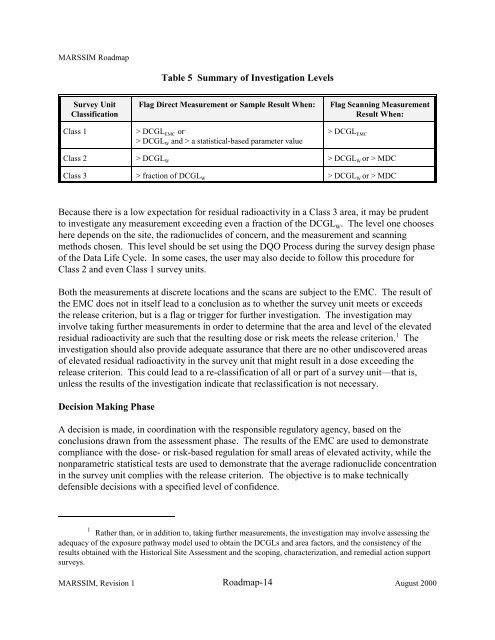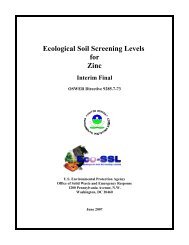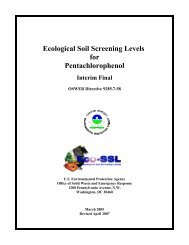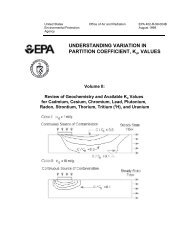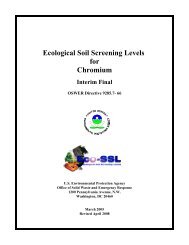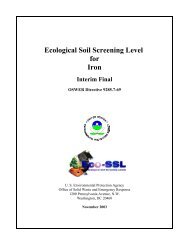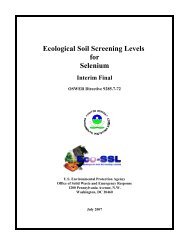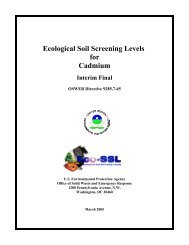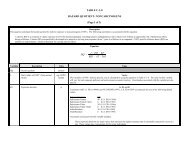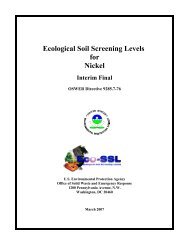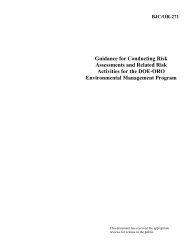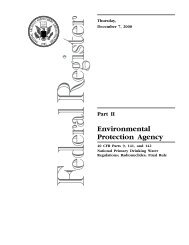- Page 2 and 3: AUGUST 2000 REVISION 1 MULTI-AGENCY
- Page 4 and 5: DISCLAIMER This manual was prepared
- Page 6 and 7: CONTENTS Page 2.5.4 Design Consider
- Page 8 and 9: CONTENTS Page 5.5 Final Status Surv
- Page 10 and 11: CONTENTS Page 8.2.4 Verify the Assu
- Page 12 and 13: CONTENTS Page Appendix I Statistica
- Page 14 and 15: LIST OF TABLES Page 6.7 NaI(Tl) Sci
- Page 16 and 17: CONTENTS LIST OF FIGURES Page 1.1 C
- Page 18 and 19: LIST OF FIGURES Page I.1 Example of
- Page 20 and 21: ACKNOWLEDGMENTS DOE: Robert Coleman
- Page 22 and 23: MARSSIM, Revision 1 xxii August 200
- Page 24 and 25: ABBREVIATIONS FEMA Federal Emergenc
- Page 26 and 27: ABBREVIATIONS UMTRCA Uranium Mill T
- Page 28 and 29: ERRATA AND ADDENDA In response to c
- Page 30 and 31: MARSSIM Roadmap users already famil
- Page 32 and 33: MARSSIM Roadmap A minimum amount of
- Page 34 and 35: MARSSIM Roadmap Group/Separate Area
- Page 36 and 37: MARSSIM Roadmap The next step, afte
- Page 38 and 39: MARSSIM Roadmap Class 1 CONDUCT SUR
- Page 40 and 41: MARSSIM Roadmap be modified (Sectio
- Page 44 and 45: 1 INTRODUCTION 1.1 Purpose and Scop
- Page 46 and 47: Introduction MARSSIM presents compr
- Page 48 and 49: Introduction MARSSIM contains sever
- Page 50 and 51: 1.4 Missions of the Federal Agencie
- Page 52 and 53: Table 1.1 Scope of MARSSIM (continu
- Page 54 and 55: Overview of the Radiation Survey an
- Page 56 and 57: Overview of the Radiation Survey an
- Page 58 and 59: Overview of the Radiation Survey an
- Page 60 and 61: Overview of the Radiation Survey an
- Page 62 and 63: Overview of the Radiation Survey an
- Page 64 and 65: Overview of the Radiation Survey an
- Page 66 and 67: Overview of the Radiation Survey an
- Page 68 and 69: Overview of the Radiation Survey an
- Page 70 and 71: Overview of the Radiation Survey an
- Page 72 and 73: Overview of the Radiation Survey an
- Page 74 and 75: Overview of the Radiation Survey an
- Page 76 and 77: Overview of the Radiation Survey an
- Page 78 and 79: Overview of the Radiation Survey an
- Page 80 and 81: Overview of the Radiation Survey an
- Page 82 and 83: Overview of the Radiation Survey an
- Page 84 and 85: Overview of the Radiation Survey an
- Page 86 and 87: Overview of the Radiation Survey an
- Page 88 and 89: MARSSIM, Revision 1 2-36 August 200
- Page 90 and 91: L@QRRHL+ Qduhrhnm 0 1,27 August 200
- Page 92 and 93:
Nudquhdv ne sgd Q`ch`shnm Rtqudx `m
- Page 94 and 95:
Historical Site Assessment EPA’s
- Page 96 and 97:
Historical Site Assessment 3.3 Site
- Page 98 and 99:
Historical Site Assessment Table 3.
- Page 100 and 101:
Historical Site Assessment 3.4.1.2
- Page 102 and 103:
Historical Site Assessment access a
- Page 104 and 105:
Historical Site Assessment Site ope
- Page 106 and 107:
Historical Site Assessment sites wh
- Page 108 and 109:
Historical Site Assessment ! Is sur
- Page 110 and 111:
Historical Site Assessment ! Are so
- Page 112 and 113:
Historical Site Assessment ! Were t
- Page 114 and 115:
Historical Site Assessment availabl
- Page 116 and 117:
Historical Site Assessment 3.7 Dete
- Page 118 and 119:
Historical Site Assessment 1. Gloss
- Page 120 and 121:
Preliminary Survey Considerations I
- Page 122 and 123:
Preliminary Survey Considerations T
- Page 124 and 125:
Preliminary Survey Considerations A
- Page 126 and 127:
Preliminary Survey Considerations 4
- Page 128 and 129:
Preliminary Survey Considerations F
- Page 130 and 131:
Preliminary Survey Considerations !
- Page 132 and 133:
Preliminary Survey Considerations T
- Page 134 and 135:
Preliminary Survey Considerations 4
- Page 136 and 137:
Preliminary Survey Considerations I
- Page 138 and 139:
Preliminary Survey Considerations N
- Page 140 and 141:
Preliminary Survey Considerations 4
- Page 142 and 143:
Preliminary Survey Considerations c
- Page 144 and 145:
Preliminary Survey Considerations 4
- Page 146 and 147:
Preliminary Survey Considerations 1
- Page 148 and 149:
Preliminary Survey Considerations 4
- Page 150 and 151:
Preliminary Survey Considerations 4
- Page 152 and 153:
Preliminary Survey Considerations !
- Page 154 and 155:
Preliminary Survey Considerations T
- Page 156 and 157:
Preliminary Survey Considerations s
- Page 158 and 159:
5.1 Introduction 5 SURVEY PLANNING
- Page 160 and 161:
Survey Planning and Design residual
- Page 162 and 163:
SURVEY DESIGN EXAMPLE SCOPING SURVE
- Page 164 and 165:
5.3 Characterization Surveys 5.3.1
- Page 166 and 167:
Survey Planning and Design The char
- Page 168 and 169:
5.3.3.2 Land Area Surveys Survey Pl
- Page 170 and 171:
Survey Planning and Design Each sur
- Page 172 and 173:
5.3.5 Documentation Survey Planning
- Page 174 and 175:
Survey Planning and Design _______
- Page 176 and 177:
Survey Planning and Design There wi
- Page 178 and 179:
5.5 Final Status Surveys 5.5.1 Gene
- Page 180 and 181:
ESTIMATE F, THE VARIABILITY IN THE
- Page 182 and 183:
5.5.2.1 Application of Decommission
- Page 184 and 185:
Survey Planning and Design of , all
- Page 186 and 187:
Survey Planning and Design The valu
- Page 188 and 189:
Survey Planning and Design the same
- Page 190 and 191:
Survey Planning and Design Calculat
- Page 192 and 193:
Survey Planning and Design The numb
- Page 194 and 195:
Nuclide Am-241 Co-60 Cs-137 Ni-63 R
- Page 196 and 197:
Survey Planning and Design When the
- Page 198 and 199:
85N 80N 70N 60N 50N 40N 30N 20N 10N
- Page 200 and 201:
85N 80N 70N 60N 50N 40N 30N 20N 10N
- Page 202 and 203:
Survey Unit Classification Table 5.
- Page 204 and 205:
Area Classification Survey Planning
- Page 206 and 207:
Survey Planning and Design location
- Page 208 and 209:
Survey Planning and Design If small
- Page 210 and 211:
SURVEY PREPARATIONS EXAMPLE FINAL S
- Page 212 and 213:
CONDUCTING SURVEYS _______ Perform
- Page 214 and 215:
Field Measurement Methods and Instr
- Page 216 and 217:
Field Measurement Methods and Instr
- Page 218 and 219:
Field Measurement Methods and Instr
- Page 220 and 221:
Field Measurement Methods and Instr
- Page 222 and 223:
Field Measurement Methods and Instr
- Page 224 and 225:
Field Measurement Methods and Instr
- Page 226 and 227:
Field Measurement Methods and Instr
- Page 228 and 229:
Field Measurement Methods and Instr
- Page 230 and 231:
Field Measurement Methods and Instr
- Page 232 and 233:
Field Measurement Methods and Instr
- Page 234 and 235:
Field Measurement Methods and Instr
- Page 236 and 237:
Field Measurement Methods and Instr
- Page 238 and 239:
Field Measurement Methods and Instr
- Page 240 and 241:
Field Measurement Methods and Instr
- Page 242 and 243:
Field Measurement Methods and Instr
- Page 244 and 245:
Field Measurement Methods and Instr
- Page 246 and 247:
Field Measurement Methods and Instr
- Page 248 and 249:
Field Measurement Methods and Instr
- Page 250 and 251:
Field Measurement Methods and Instr
- Page 252 and 253:
Field Measurement Methods and Instr
- Page 254 and 255:
Field Measurement Methods and Instr
- Page 256 and 257:
Field Measurement Methods and Instr
- Page 258 and 259:
Field Measurement Methods and Instr
- Page 260 and 261:
Field Measurement Methods and Instr
- Page 262 and 263:
Field Measurement Methods and Instr
- Page 264 and 265:
Field Measurement Methods and Instr
- Page 266 and 267:
Field Measurement Methods and Instr
- Page 268 and 269:
Field Measurement Methods and Instr
- Page 270 and 271:
Field Measurement Methods and Instr
- Page 272 and 273:
Field Measurement Methods and Instr
- Page 274 and 275:
Field Measurement Methods and Instr
- Page 276 and 277:
Field Measurement Methods and Instr
- Page 278 and 279:
Field Measurement Methods and Instr
- Page 280 and 281:
Sampling and Preparation for Labora
- Page 282 and 283:
Sampling and Preparation for Labora
- Page 284 and 285:
Sampling and Preparation for Labora
- Page 286 and 287:
Sampling and Preparation for Labora
- Page 288 and 289:
Sampling and Preparation for Labora
- Page 290 and 291:
Sampling and Preparation for Labora
- Page 292 and 293:
Sampling and Preparation for Labora
- Page 294 and 295:
Sampling and Preparation for Labora
- Page 296 and 297:
Sampling and Preparation for Labora
- Page 298 and 299:
MARSSIM, Revision 1 7-20 August 200
- Page 300 and 301:
Sampling and Preparation for Labora
- Page 302 and 303:
Sampling and Preparation for Labora
- Page 304 and 305:
Sampling and Preparation for Labora
- Page 306 and 307:
Sampling and Preparation for Labora
- Page 308 and 309:
Interpretation of Survey Results 8.
- Page 310 and 311:
Interpretation of Survey Results 8.
- Page 312 and 313:
Interpretation of Survey Results 8.
- Page 314 and 315:
Interpretation of Survey Results On
- Page 316 and 317:
Interpretation of Survey Results 8.
- Page 318 and 319:
Interpretation of Survey Results gr
- Page 320 and 321:
Interpretation of Survey Results Ta
- Page 322 and 323:
Interpretation of Survey Results Ta
- Page 324 and 325:
Interpretation of Survey Results me
- Page 326 and 327:
Interpretation of Survey Results Ta
- Page 328 and 329:
Interpretation of Survey Results Th
- Page 330 and 331:
Interpretation of Survey Results ra
- Page 332 and 333:
Interpretation of Survey Results in
- Page 334 and 335:
9.1 Introduction 9 QUALITY ASSURANC
- Page 336 and 337:
9.2 Development of a Quality Assura
- Page 338 and 339:
Project Management Title and Approv
- Page 340 and 341:
9.3.2 Data Validation Quality Assur
- Page 342 and 343:
Data Descriptor Analytical Method a
- Page 344 and 345:
References American Society of Test
- Page 346 and 347:
References Department of Energy (DO
- Page 348 and 349:
References Environmental Protection
- Page 350 and 351:
References Environmental Protection
- Page 352 and 353:
References Environmental Protection
- Page 354 and 355:
References National Council on Radi
- Page 356 and 357:
References Nuclear Regulatory Commi
- Page 358 and 359:
References 10 CFR Part 50, Appendix
- Page 360 and 361:
References U.S. Federal Code Atomic
- Page 362 and 363:
Appendix A A.2.2 Determine Residual
- Page 364 and 365:
Appendix A M ANUFACTURING ADM INIST
- Page 366 and 367:
Appendix A Interior Concrete Survey
- Page 368 and 369:
Appendix A 18S 20S 22S 24S 26S 28S
- Page 370 and 371:
Appendix A A.3.3 Specify Sample Col
- Page 372 and 373:
Appendix A Probability Survey Unit
- Page 374 and 375:
Appendix A The result for L was rou
- Page 376 and 377:
Appendix A The stem and leaf displa
- Page 378 and 379:
Appendix A Table A.3 WRS Test for C
- Page 380 and 381:
Appendix A Probability Survey Unit
- Page 382 and 383:
Appendix B ! minimum detectable con
- Page 384 and 385:
Appendix C The principal radiologic
- Page 386 and 387:
Appendix C C.1.5 The Office of Prev
- Page 388 and 389:
Appendix C C.2.1.2 Energy Reorganiz
- Page 390 and 391:
Appendix C C.2.3 DOE Regulations an
- Page 392 and 393:
Appendix C B. ALARA DOE Guidance: D
- Page 394 and 395:
Appendix C consistent with the requ
- Page 396 and 397:
Appendix C The principal radiologic
- Page 398 and 399:
Appendix C components that contain
- Page 400 and 401:
Appendix C C.4.5 DOD Regulations Co
- Page 402 and 403:
Appendix C 6. NAVMEDCOM 6470.10, In
- Page 404 and 405:
APPENDIX D THE PLANNING PHASE OF TH
- Page 406 and 407:
Start Developing DQOs HSA Develop a
- Page 408 and 409:
D.2 Identify the Decision Appendix
- Page 410 and 411:
Appendix D ! spatial boundaries tha
- Page 412 and 413:
Appendix D The mean is the value th
- Page 414 and 415:
Contamination Distribution f(*) 0 0
- Page 416 and 417:
Appendix D decision rule, an estima
- Page 418 and 419:
Table D.1 Example Representation of
- Page 420 and 421:
hypothesis is rejected. The decisio
- Page 422 and 423:
SCENARIO B Appendix D Assume as a n
- Page 424 and 425:
Appendix D Once the preliminary est
- Page 426 and 427:
Appendix D dose or risk is approxim
- Page 428 and 429:
Acceptable Probability of Deciding
- Page 430 and 431:
Acceptable Error Rates 1.00 0.20 0.
- Page 432 and 433:
Appendix D ! Documenting the operat
- Page 434 and 435:
Appendix E Routine Data INPUTS DATA
- Page 436 and 437:
Appendix E E.3 Select the Statistic
- Page 438 and 439:
APPENDIX F THE RELATIONSHIP BETWEEN
- Page 440 and 441:
Appendix F extent and type of relea
- Page 442 and 443:
@tftrs 1/// E,4 L@QRRHL+ Qduhrhnm 0
- Page 444 and 445:
@tftrs 1/// E,6 L@QRRHL+ Qduhrhnm 0
- Page 446 and 447:
@tftrs 1/// E,8 L@QRRHL+ Qduhrhnm 0
- Page 448 and 449:
-- -- -- -- -- -- -- -- -- -- APPEN
- Page 450 and 451:
General Stratigraphy USGS Topograph
- Page 452 and 453:
Table G.1 Site Assessment Informati
- Page 454 and 455:
Table G.2 Site Assessment Informati
- Page 456 and 457:
Table G.2 Site Assessment Informati
- Page 458 and 459:
Table G.2 Site Assessment Informati
- Page 460 and 461:
Table G.2 Site Assessment Informati
- Page 462 and 463:
Table G.2 Site Assessment Informati
- Page 464 and 465:
Table G.2 Site Assessment Informati
- Page 466 and 467:
Table G.2 Site Assessment Informati
- Page 468 and 469:
Table G.2 Site Assessment Informati
- Page 470 and 471:
APPENDIX H DESCRIPTION OF FIELD SUR
- Page 472 and 473:
H.1 INTRODUCTION Appendix H This ap
- Page 474 and 475:
H.2 FIELD SURVEY EQUIPMENT ------ H
- Page 476 and 477:
System: ALPHA TRACK DETECTOR Lab/Fi
- Page 478 and 479:
Appendix H System: GAS-FLOW PROPORT
- Page 480 and 481:
H.2 FIELD SURVEY EQUIPMENT --------
- Page 482 and 483:
Appendix H System: GAS-FLOW PROPORT
- Page 484 and 485:
H.2 FIELD SURVEY EQUIPMENT ------ H
- Page 486 and 487:
System: GM SURVEY METER WITH GAMMA
- Page 488 and 489:
System: HAND-HELD PRESSURIZED ION C
- Page 490 and 491:
Appendix H Calibration based on Mon
- Page 492 and 493:
Appendix H System: SODIUM IODIDE SU
- Page 494 and 495:
H.2 FIELD SURVEY EQUIPMENT --------
- Page 496 and 497:
Appendix H System: ALPHA TRACK DETE
- Page 498 and 499:
System: ELECTRET ION CHAMBER Lab/Fi
- Page 500 and 501:
H.2 FIELD SURVEY EQUIPMENT ------ H
- Page 502 and 503:
System: FIELD X-RAY FLUORESCENCE SP
- Page 504 and 505:
Appendix H System: CHEMICAL SPECIES
- Page 506 and 507:
Appendix H Specificity/Sensitivity:
- Page 508 and 509:
Appendix H System: ALPHA SPECTROSCO
- Page 510 and 511:
Appendix H System: LIQUID SCINTILLA
- Page 512 and 513:
H.3 LABORATORY INSTRUMENTS --------
- Page 514 and 515:
Appendix H System: LIQUID SCINTILLA
- Page 516 and 517:
Appendix H System: GERMANIUM DETECT
- Page 518 and 519:
EQUIPMENT SUMMARY TABLES Table H.1
- Page 520 and 521:
August 2000 H-51 MARSSIM, Revision
- Page 522 and 523:
August 2000 H-53 MARSSIM, Revision
- Page 524 and 525:
@tftrs 1/// G,44 L@QRRHL+ Qduhrhnm
- Page 526 and 527:
I.1 Normal Distribution APPENDIX I
- Page 528 and 529:
Δ/σ Δ/σ Appendix I Table I.2b S
- Page 530 and 531:
N 31 32 33 34 35 36 37 38 39 40 41
- Page 532 and 533:
Table I.4 Critical Values for the W
- Page 534 and 535:
Table I.4 Critical Values for the W
- Page 536 and 537:
I.5 Probability of Detecting an Ele
- Page 538 and 539:
Appendix I Table I.5 isk that an El
- Page 540 and 541:
Table I.6 1,000 Random Numbers Unif
- Page 542 and 543:
I.7 Stem and Leaf Display Appendix
- Page 544 and 545:
Table I.7 Data for Quantile Plot Da
- Page 546 and 547:
Appendix I Figure I.3 Quantile Plot
- Page 548 and 549:
The results of these calculations a
- Page 550 and 551:
I.9 Power Calculations for the Stat
- Page 552 and 553:
I.9.2 Power of the Wilcoxon Rank Su
- Page 554 and 555:
Probability survey Unit Passes 1 0.
- Page 556 and 557:
Appendix I I.11 Multiple Radionucli
- Page 558 and 559:
Appendix I the quantity to be measu
- Page 560 and 561:
Appendix I Table I.12 Example WRS T
- Page 562 and 563:
APPENDIX J DERIVATION OF ALPHA SCAN
- Page 564 and 565:
where: Giving: P($1) = 0.9 d/v = t
- Page 566 and 567:
Appendix J Ehftqd I-0 Oqna`ahkhsx '
- Page 568 and 569:
Appendix J Ehftqd I-2 Oqna`ahkhsx '
- Page 570 and 571:
Appendix J Ehftqd I-4 Oqna`ahkhsx '
- Page 572 and 573:
APPENDIX K COMPARISON TABLES BETWEE
- Page 574 and 575:
Table K.2 Comparison of EPA QA/R-5
- Page 576 and 577:
Table K.4 Comparison of EPA QA/R-5
- Page 578 and 579:
APPENDIX L REGIONAL RADIATION PROGR
- Page 580 and 581:
L.2 Environmental Protection Agency
- Page 582 and 583:
L.3 Nuclear Regulatory Commission (
- Page 584 and 585:
L.5 Department of the Navy The foll
- Page 586 and 587:
M.1 Introduction APPENDIX M SAMPLIN
- Page 588 and 589:
Appendix M ! Key Features of This D
- Page 590 and 591:
Appendix M ! Key Features of This D
- Page 592 and 593:
Appendix M Environmental Protection
- Page 594 and 595:
! General Description of Document:
- Page 596 and 597:
APPENDIX N Data Validation Using Da
- Page 598 and 599:
Appendix N ! Corrective action repo
- Page 600 and 601:
concerning non-detects or detection
- Page 602 and 603:
Quality Control Criterion Spikes (H
- Page 604 and 605:
Minimum Considerations for Precisio
- Page 606 and 607:
N.6.3 Accuracy Appendix N Accuracy
- Page 608 and 609:
Table N.4 Minimum Considerations fo
- Page 610 and 611:
Minimum Considerations for Comparab
- Page 612 and 613:
Appendix N If a Class 3 survey unit
- Page 614 and 615:
GLOSSARY 91b material: Any material
- Page 616 and 617:
Becquerel (Bq): The International S
- Page 618 and 619:
composite sample: A sample formed b
- Page 620 and 621:
Glossary data quality indicators: M
- Page 622 and 623:
elevated measurement: A measurement
- Page 624 and 625:
Glossary impacted area: Any area th
- Page 626 and 627:
micrometeorology: The study of weat
- Page 628 and 629:
Glossary performance evaluation: A
- Page 630 and 631:
adioactivity: The mean number of nu
- Page 632 and 633:
Glossary replicate: A repeated anal
- Page 634 and 635:
size (of a test): See alpha. soil:
- Page 636 and 637:
Glossary TEDE (total effective dose
- Page 638 and 639:
see Type I decision error see Type
- Page 640 and 641:
criterion alternate hypothesis comp
- Page 642 and 643:
final status survey (continued) hea
- Page 644 and 645:
nonparametric test 2-26; 4-10, 11;
- Page 646 and 647:
sample(s) (continued) documentation
- Page 648 and 649:
surveyor(s) 4-22, 31; 6-24, 37, 38,
- Page 650 and 651:
References American Society of Test
- Page 652 and 653:
References Department of Energy (DO
- Page 654 and 655:
References Environmental Protection
- Page 656 and 657:
References Environmental Protection
- Page 658 and 659:
References Environmental Protection
- Page 660 and 661:
References National Council on Radi
- Page 662 and 663:
References Nuclear Regulatory Commi
- Page 664 and 665:
References 10 CFR Part 50, Appendix
- Page 666:
References U.S. Federal Code Atomic


